“What do we want? Climate Justice!”
Climate Laws and Activism: Communities Take Action
By Stephanie Lemesianou
Seventeen-year-old Anna Buretta knew exactly what she was fighting for when stationed outside New York City Hall. Holding a megaphone in one hand and a cardboard sign in the other, she was leading a chant, surrounded by her peers from Fridays for Future New York City, a youth climate action group. When a man twice her age and size began questioning her knowledge, she decided to confront him.
Her choice of defense was naming a legal agreement.
“This is about the Fossil Fuel Non-Proliferation Treaty,” she said.
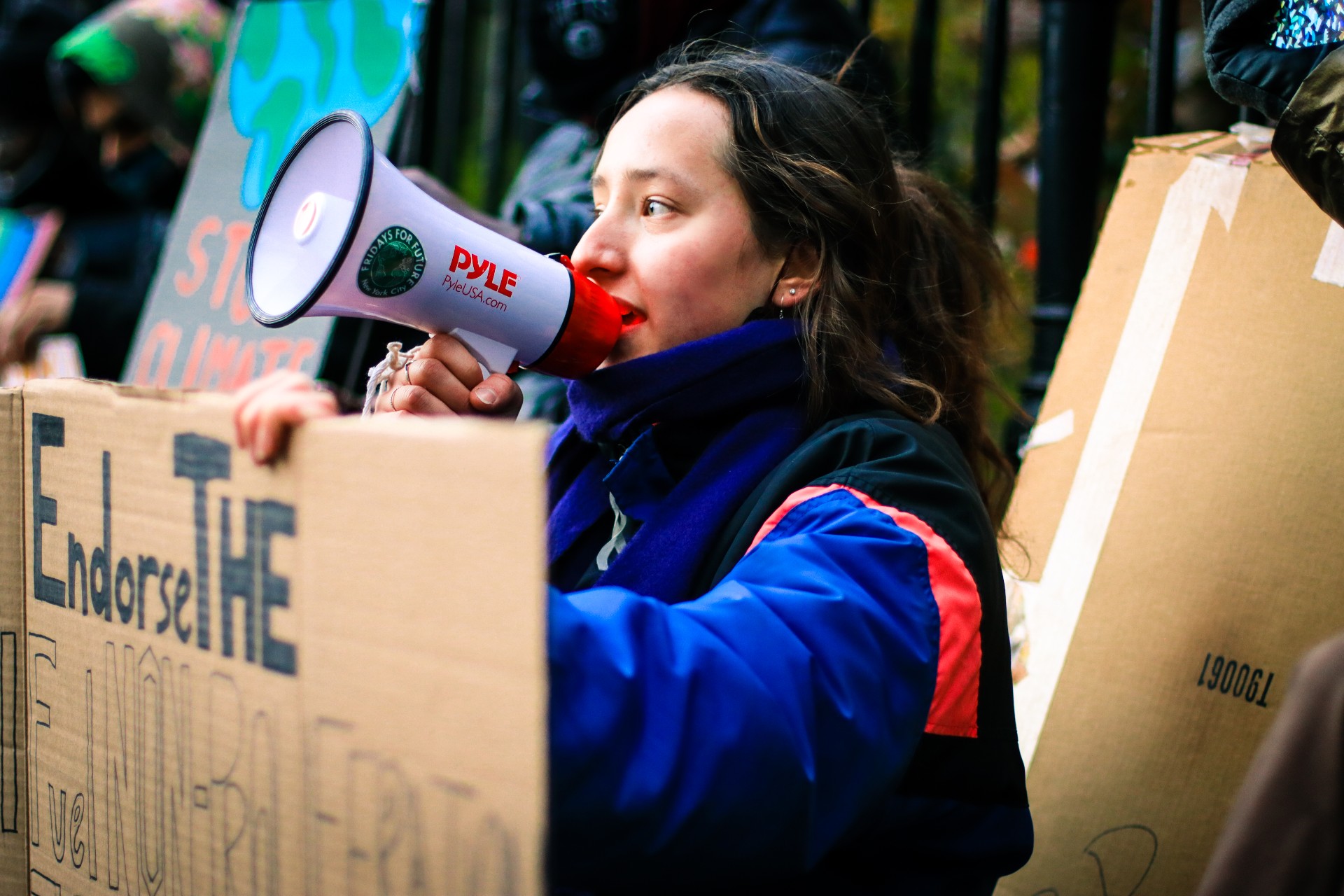
Anna Buretta protesting outside of New York City Hall.
Inspired by her sister who’s an environmental activist, Buretta joined the organization almost a year ago and initially began working on climate legislation outreach. Now, she feels like she found her place in the climate movement through strike-planning. She believes that in order to enact proper change, protests need to have a clear message and purpose.
“When you have a bill, you have a really concrete goal for your protest and you know exactly what you’re fighting for and there’s no confusion,” she said.
Across the state of New York, environmental, justice and community groups are working on educating people about climate laws and how to participate in the implementation process. Increasingly, ordinary community members find themselves on the front lines of fossil fuel projects and climate change actions, citing existing laws and demanding that they be enforced. Under Gov. Kathy Hochul’s new administration, climate campaigners have been testing the waters to see how far community action can affect state-level decision-making and enforcement of legislation.
According to Ruhan Nagra, the director of the Environmental Justice Initiative and the senior clinical supervisor at the University Network for Human Rights, environmental and climate law is moving in a direction that’s much more community focused. This is evident in New York’s landmark law, the Climate Leadership and Community Protection Act.
“I think the environmental justice protections built into the CLCPA are very significant, and absolutely a result of all of the grassroots organizing that’s happened in order to make these sorts of climate justice laws a reality,” she said.
The CLCPA was signed into law in July 2019 by former Gov. Andrew Cuomo. It requires New York to reduce greenhouse gas emissions from all sectors of the economy 40% by 2030 and more than 85% by 2050 from the 1990 levels. It also states that New York has to achieve 100% zero-emission electricity by 2040 and 70% renewable energy by 2030.
In daily life, these targets could translate into a significant reduction in local pollution, respiratory illnesses, energy consumption and utility bills. They can also mean equal access to clean energy solutions and the creation of new green jobs.
“I have to agree that the climate law is groundbreaking,” said Amanda Sachs, the legislative and climate associate from Environmental Advocates NY. “Not only does it have the boldest goals of any state in terms of targets, but it really prioritizes equity.”
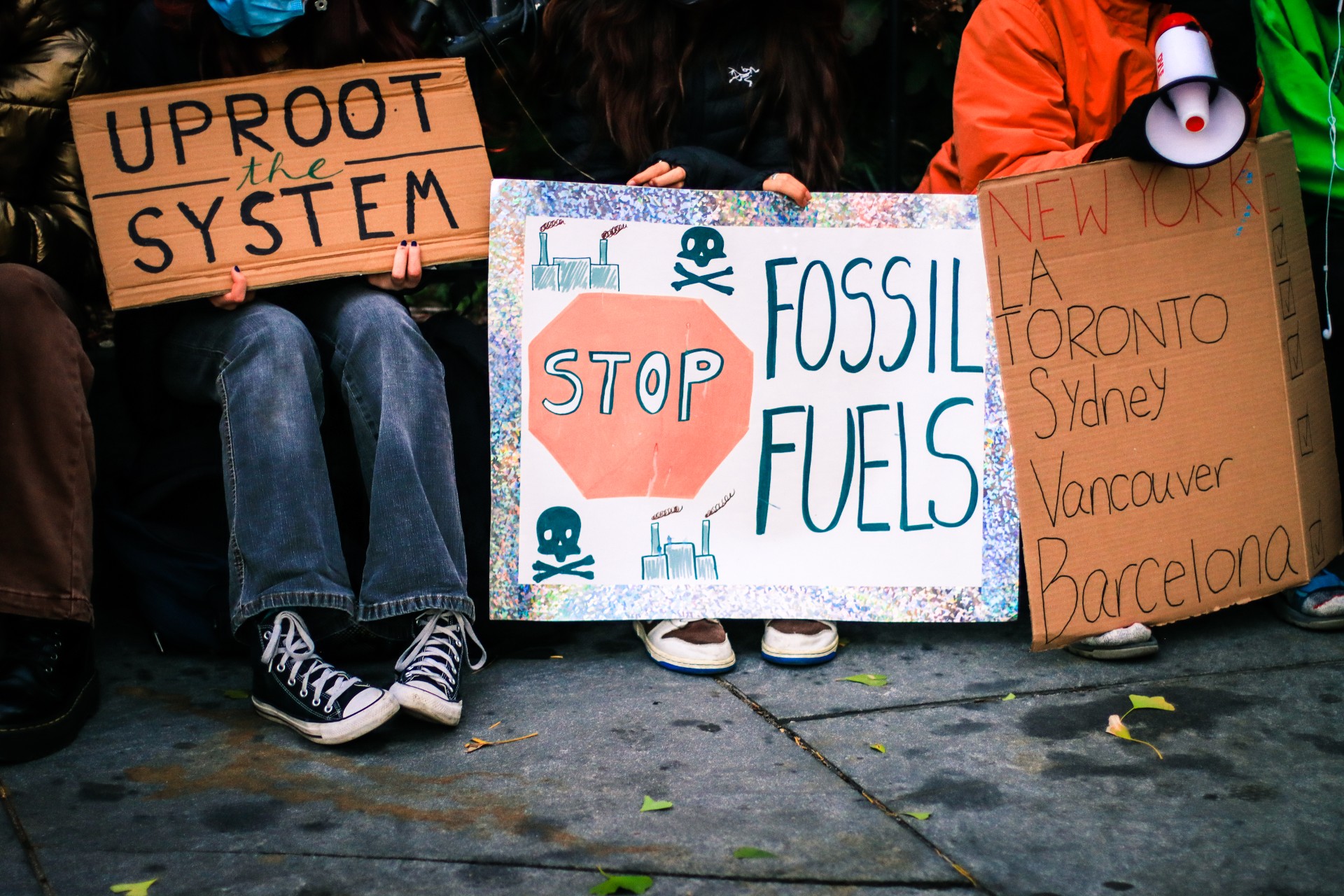
Protesters from Fridays for Future NYC outside of New York City Hall.
To meet the objectives set out in the law, a 22-member committee was formed called the New York State Climate Action Council. Led by the Department of Environmental Conservation and the New York State Energy Research and Development Authority, it is responsible for producing a Scoping Plan. Their meetings, agendas and presentations are all accessible to the public online.
In October, the DEC denied air permits for NRG’s Astoria Plant and the Danskammer Plant, stating that the proposals were not in compliance with the requirements of the CLCPA. Climate activists and elected officials who opposed the projects were hopeful that this could set a precedent for future permits.
“Our community drew a line in the sand against new fossil fuel infrastructure and won. Let this be a statement of what our policy should be as we fight the ravages of the climate crisis,” said State Senate Deputy Leader Michael Gianaris in a public statement about the Astoria Plant.
Alice Hu, a climate campaigner with New York Communities for Change, was part of the No Astoria NRG Plant Coalition.
“In the world that we live in we definitely need to make sure that politicians know that they’re gonna be held accountable if they don’t follow this law and they don’t follow the science, they don’t think about the wellbeing of public constituents,” she said.
Hu mostly works with members from low-income communities of color, organizing around issues of housing, labor laws and immigration laws. Part of her organization’s climate education is about making people realize that the climate crisis can also affect their day-to-day lives.
“We’re a coastal community and we’re also an unequal city, so when you have those two things combined you realize who is hit most hard, who is affected the most,” she said.
Recognizing and defining within the legal framework who is affected the most is a tough decision assigned to the Climate Justice Working Group. The 13-member advisory group is part of the CLCPA law and consists of environmental justice advocates who directly engage with ordinary community members statewide through direct work.
They are in charge of identifying and distinguishing disadvantaged communities who are marginalized and vulnerable to co-pollutants and greenhouse gas emissions, but also communities who would benefit most from investment allocations. The CLCPA requires that these disadvantaged communities receive at least 35% of overall benefits spending on clean energy and other projects such as housing, transportation and economic development.
This is no easy task, as every decision could greatly affect how effective the policy will be in reaching the communities who are most in need.
“As we recognize the fact that climate change and environmental issues disproportionately affect the most marginalized people, we realize that actually these are human rights issues,” said Nagra.
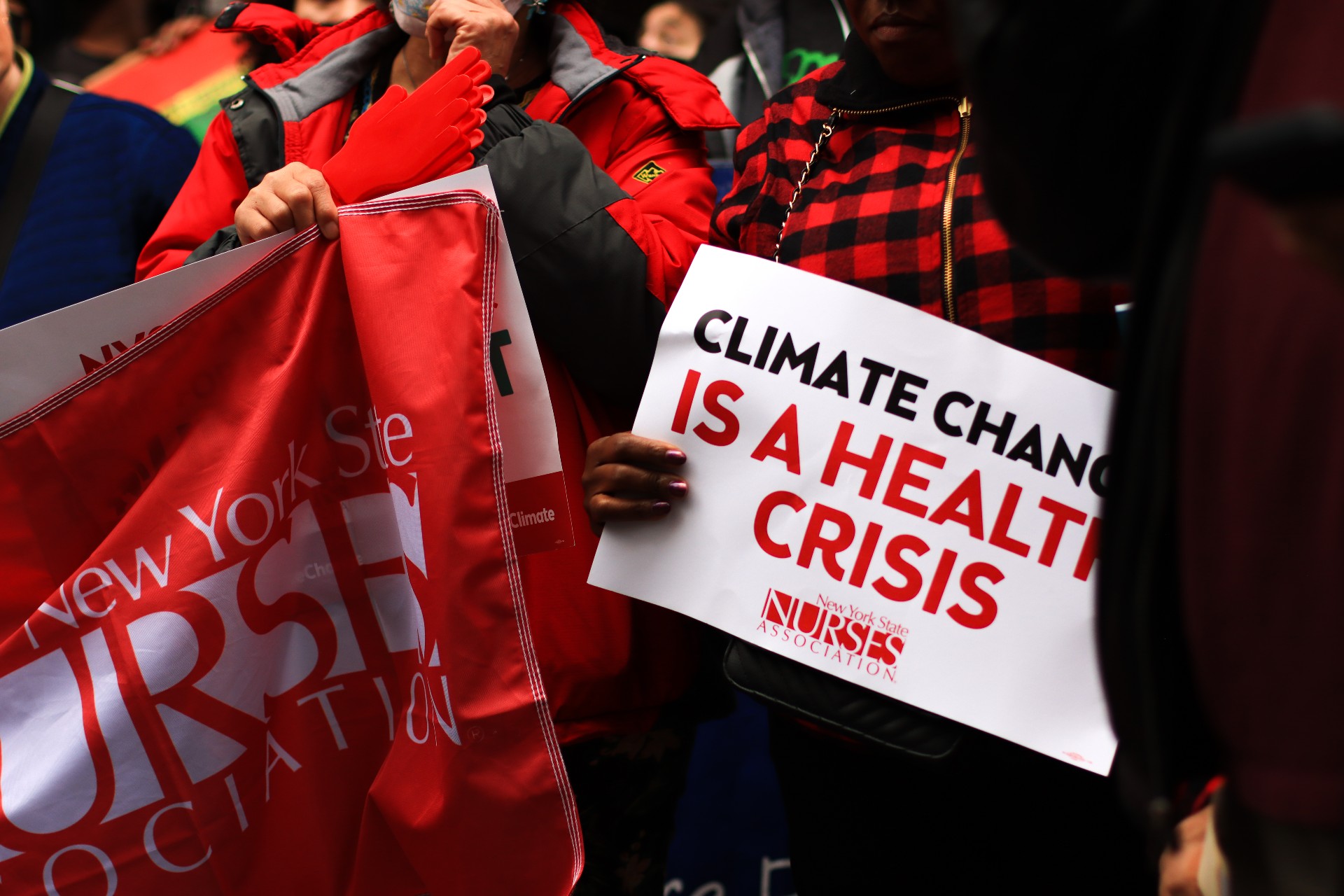
The NY State Nurses Association at the Climate Community Investment Act rally in New York City.
With the pandemic, the stakes are even higher for defining disadvantaged communities.
On Nov. 13th, community groups from the NY Renews coalition, including members of the Climate Justice Working Group, attended a rally outside of Hochul’s New York Office. Community members and elected officials called for the passing of the make sure the link covers the full act Climate and Community Investment Act, a bill that will also create a revenue distribution system that prioritizes disadvantaged communities.
“We have seen the impact that the pandemic has had on low-income communities of color… We have already seen the destruction that climate change and environmental degradation has had on the health of our patients,” said Nella Pineda-Macron from the New York State Nurses Association at the rally.
The work of the Climate Justice Working Group is an example of how community activism and collective action can inform climate legislation. With decades of experience, the members are using their resources to bridge the gap between underrepresented constituents who are affected by climate pollution and other socioeconomic factors.
“I wish that heads of grassroot organizations and environmental justice communities were tapped on more. I know they’re stretched thin but they just do incredible work,” said Sachs.
For laws like the CLCPA and the CCIA, language and definitions are very important. Legal language can affect how a climate law is enforced or even understood. Sometimes broader language is preferable, based on what needs to be considered or covered in a law.
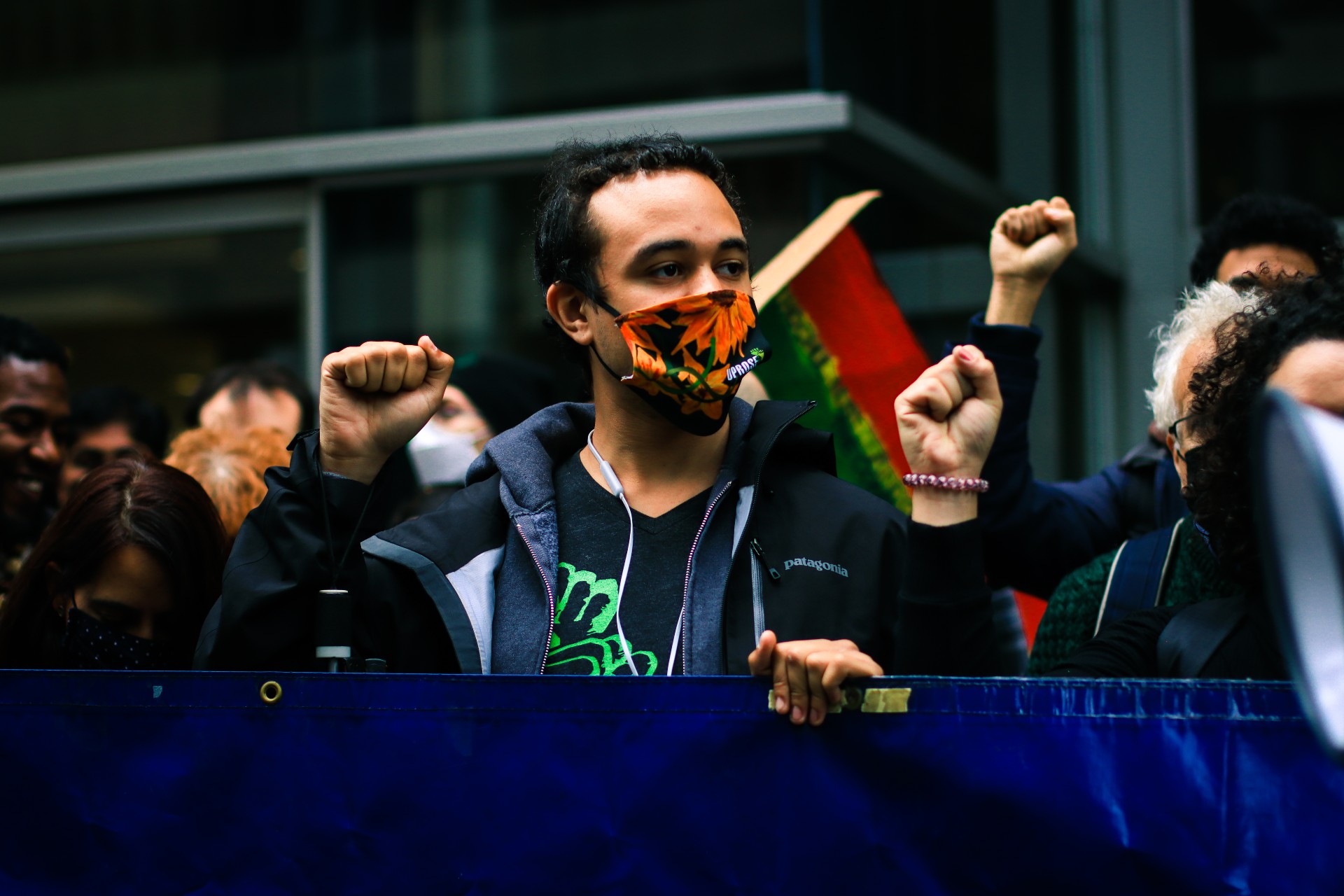
Protester at the Climate and Community Investment Act rally in New York City.
In the November elections, an overwhelming number of New York voters approved an amendment to the New York Constitution, stating that “each person shall have a right to clean air and water, and a healthful environment.” While this successfully passed and became an inalienable right in the constitution, some voters were confused by the broad language.
The broad language in the New York Constitution amendment is purposeful, in order to ensure that government-decision making considers all types of environmental impact, from water contamination to access to green space.
“It’s very new, so we’ll see what decisions are made which will set a precedent for what these terms actually end up meaning,” she said.
Following the development of climate legislation from conception to enforcement can be an overwhelming process for ordinary community members but even for those involved in the climate movement.
“I think it’s really hard to keep on top of all the bills and all the legislation and literature surrounding the climate crisis, it can be very overwhelming … and I actually find that many News sites actually don’t do a great job covering climate change and climate laws,” said Buretta.“I’m certainly not as educated as I should be, but it’s a constant standard that you have to hold yourself to, you know?”
The Clock is Ticking
Protecting Coastal Ecosystems for Climate Change Education
By Mehar Gujral
On a cold, gray afternoon in December, Don Riepe is out on the water, navigating his 22-foot boat Oystercatcher through salt marshes.
Wintering waterfowl and Brant geese fly overhead, with the Manhattan skyline hazy in the distance.
“Probably as we speak we’re losing a species or more,” says Riepe, the 82-year-old Jamaica Bay Guardian for the American Littoral Society. “Saving them is a climate change issue.”

The view of Jamaica Bay with the Manhattan skyline in the background from the dock of Don Riepe’s home in Broad Channel, Queens. Riepe is on his boat, the Oystercatcher, as a seagull looks on.
The Jacques Cousteau of Jamaica Bay, the local conservationist has worked to protect the species and ecosystems on this edge of New York for decades. He says protecting coastal ecosystems such as this one is key to addressing the climate crisis and providing climate change education.
Jamaica Bay is an 18,000-acre wetland estuary surrounded by the Rockaway Peninsula to the South, Brooklyn to the West, and Queens to the East.
Comprising an area almost equal to that of Manhattan, the bay consists of numerous islands, a labyrinth of waterways, meadowlands, and two brackish freshwater ponds. The region currently hosts more than 325 species of birds, 50 species of butterflies, and 100 species of finfish, according to the New York City Department of Parks & Recreation.
Much of the bird activity is due to the salt marshes that dot the bay and provide habitat for the birds, as well as for the prey and grasses they feed on.
“The marshes have the species of fish and shrimp and marine life that attracts all the birds, so they’re very important,” says Riepe.
The salt marshes are an integral part of the Jamaica Bay ecosystem and to the survival of the region’s species. But they might not be around for much longer.
While recent conservation efforts, such as a marine debris removal project, have improved the condition of marshes, this valuable ecosystem continues to disappear at an alarming rate. Studies say that the hazards facing coastal wetlands are due to the intertwined impacts of human-induced stresses and sea-level rise.
The New York metropolitan region experienced a temperature rise of about 18 degrees Celsius during the last century. During this period, local sea-level has risen by nearly 30 centimeters in New York City and over half of this regional sea-level rise is linked to global warming.
Scientists fear that the salt marshes of Jamaica Bay may completely vanish within the next few decades. And as habitats disappear, they say that species would soon follow.
Back on the Oystercatcher, Riepe gestures to the expanse of the bay and the birds flying overhead.
“If we don’t take care of it, it’s not a matter of if, but when this’ll be gone.”

Don Riepe spots a seal through his binoculars.
You might have heard of COP26, the crucial climate summit that saw 20,000 government leaders, journalists, activists, and celebrities from around the world descend on Glasgow. But you’re less likely to have heard of another high-level international environmental meeting that also happened this October.
Why they convened: to address the rapid collapse of species and systems that sustain life on Earth.
Referred to by the Times as “the most important global meeting you’ve probably never heard of,” the 15th UN Biodiversity Conference held in Kunming, China brought together countries to discuss what scientists and researchers have been saying for a while. Unless the world stops treating climate change and biodiversity collapse as separate issues, neither problem can be addressed effectively.
Dr. James Higham, an assistant professor of Biological Anthropology at New York University where he also leads the Primate Reproductive Ecology and Evolution Group, underlines the dire situation facing species globally.
“If you go back to Zoo Quest, which was David Attenborough’s first black and white documentary show, there are species that they’ve got footage of that he sat and chatted about that are now extinct.”
According to a landmark study on the state of the world’s biodiversity, the Global Assessment Report on Biodiversity and Ecosystem Services by the Intergovernmental Science-Policy Platform on Biodiversity and Ecosystem Services (IPBES), an estimated million species are threatened with extinction. Scientists say the average abundance of native species in most major terrestrial biomes has fallen by at least 20 percent, mostly since 1900.
Twenty-twenty was meant to be a ‘super year’ for biodiversity. Instead, the year gave us COVID-19, wildfires, locust invasions, and record heat waves that show the catastrophic impacts of biodiversity collapse and climate change.
“It’s all a mess really,” says Higham at his office, with a skeletal model of a primate behind him.
It’s easy to think that biodiversity is something that exists in other parts of the world, particularly when we are unaccustomed to thinking about our urban regions as biologically diverse, but there are more than 7,000 species of plants and animals within the five boroughs.
New York City lies within one of the world’s 36 biodiversity hotspots, the North American Coastal Plain, as defined by the Critical Ecosystem Partnership Fund, a global program focused on providing funding for projects aimed at protecting these areas of extreme biodiversity, such as Jamaica Bay.
At the offices of the Wildlife Conservation Society (WCS), a nonprofit organization headquartered at the Bronx Zoo, John F. Calvelli, the executive vice president of public affairs, echoes Higham.
“We’re going to lose a significant number of species, there’s no way around that,” says Calvelli as the nearby exhibit of sea lions yap in background chorus. “But we all have to redouble our efforts right now because if we don’t, I really don’t want to think about what the alternative is.”
WCS, which manages four New York City wildlife parks in addition to the Bronx Zoo which sees more than 4 million visitors annually and supports conservation projects in more than 60 countries, recently launched the Framing Our Future Campaign to educate zoo visitors and digital audiences about how they can participate in nature-based solutions to climate change.
The campaign emphasizes that by saving nature, in particular restoring coastal ecosystems and protecting intact forests, we can achieve one third of the action needed to keep global temperature rise to 1.5°C by 2030.
The campaign is also working to empower people to take action on climate by advancing nature-based solutions in U.S. foreign and domestic climate policy, including the Ocean-Based Climate Solutions Act, sponsored by Rep. Raúl M. Grijalva (D-AZ), along with other priority pending legislation.
“The conservation of nature is a key component to fighting the climate crisis, which is directly linked to the extinction and pandemic crises,” says Calvelli. “We all have a role to play.”
As the child of immigrants who grew up around the corner from the Bronx Zoo on 180th street, he wants young people from underrepresented communities in New York to get involved in the fight against climate change.
“One of the things we’ve launched this year is a paid science internship program where we are leading the effort to create the next generation of science leaders in the city of New York.”
Calvelli says the program will provide one thousand paid science internships for young people from communities that have been historically underserved in the city of New York.
Some of those interns might be students from the High School for Climate Justice.
Located in East Harlem, the NYC school provides a specialized curriculum for high school students to engage in environmental studies. In a document of the school’s shared language and definitions, it defines climate justice as “(a) giving voice and agency to underrepresented and underserved groups that are disproportionately harmed by climate change and (b) minimizing the effects of climate change on all people – particularly historically marginalized people – going forward.”
The school’s Assistant Principal, Steve Stirling, says that one of the administration’s priorities is getting students outside the classroom and participating in conservation projects around the city. He counts a recent visit to Coney Island Creek, another important coastal ecosystem in the city, with the Resilient Schools Consortium as a major success.
“[The students] put on waders, walked into shallow water and did a netting experiment,” he says. “It gave them this ‘aha’ moment where there’s this aquatic life trying to live but also live amongst trash and plastic.”
“They really came back to the school just beaming and asking more questions about climate change in their classes.”
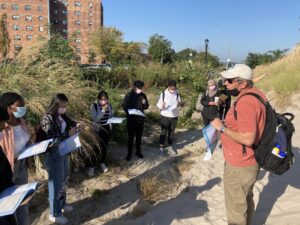
Students on-site at a conservation project in Coney Island Creek. Photo courtesy of High School for Climate Justice.
Programs at environmental-themed high schools, as well as internship initiatives by WCS and the recently launched Youth Sustainability Corps by the New York City Parks and Recreation Department, are engaging more and more young people in the city with nature-based solutions for climate change.
Back in Jamaica Bay on the Oystercatcher, Riepe spots a lone seal that’s wandered down south lounging on an islet.
“Look at it putting on a little show,” he says with delight, watching the seal bask in the limited sunshine.
Riepe says his one regret as a former high school English teacher is not doing enough to educate young people about the importance of nature and local habitats.
Today, he runs tours with schools and programs on the importance of protecting Jamaica Bay’s salt marshes and biodiversity. In his view, there’s no other option but to protect the city’s coastal ecosystems and engage young people in that effort.
“This is what we have to do. Or retreat, retreat from the coast.”
As it begins to get dark, Riepe skillfully maneuvers the boat back to his waterfront home in Broad Channel, Queens. Out on his porch as his cat Princess saunters around, watching the sun set on the Jamaica Bay salt marshes and the Manhattan skyline — almost a postcard for protecting this precious ecosystem — he says he’s hopeful but thinks the clock is ticking.
“I’m worried,” says Riepe.
“There’s great concern but we move in slow progress. We have to have debates and meetings. Nature doesn’t take any break, nature doesn’t sleep. If we want to work with it, we have to work faster.”
It Keeps on Piling
Can We Keep Up?
By Ann Gilmore
We all have a favorite shirt that we will shamelessly wear one too many times; it is more likely than not that we also own something that has been worn once or twice but simply discarded. Where does it go once we are done wearing it?
As consumers, we buy from renowned brands that can offer high quality, a buttery feel or a soft texture. On the other hand, we fall into the grips of fast fashion that can offer a similar product of lesser quality resulting in shoppers buying more items for a lesser price.
“Textile waste is one of the fastest growing waste streams in the U.S… 200,000 tons of textiles are being discarded,” said Alissa Westervelt, senior manager of DonateNYC.
According to the Sanitation Foundation, this amount equates to the height of the Empire State building (1,454 feet), approximately 139 school buses stacked on top of each other.
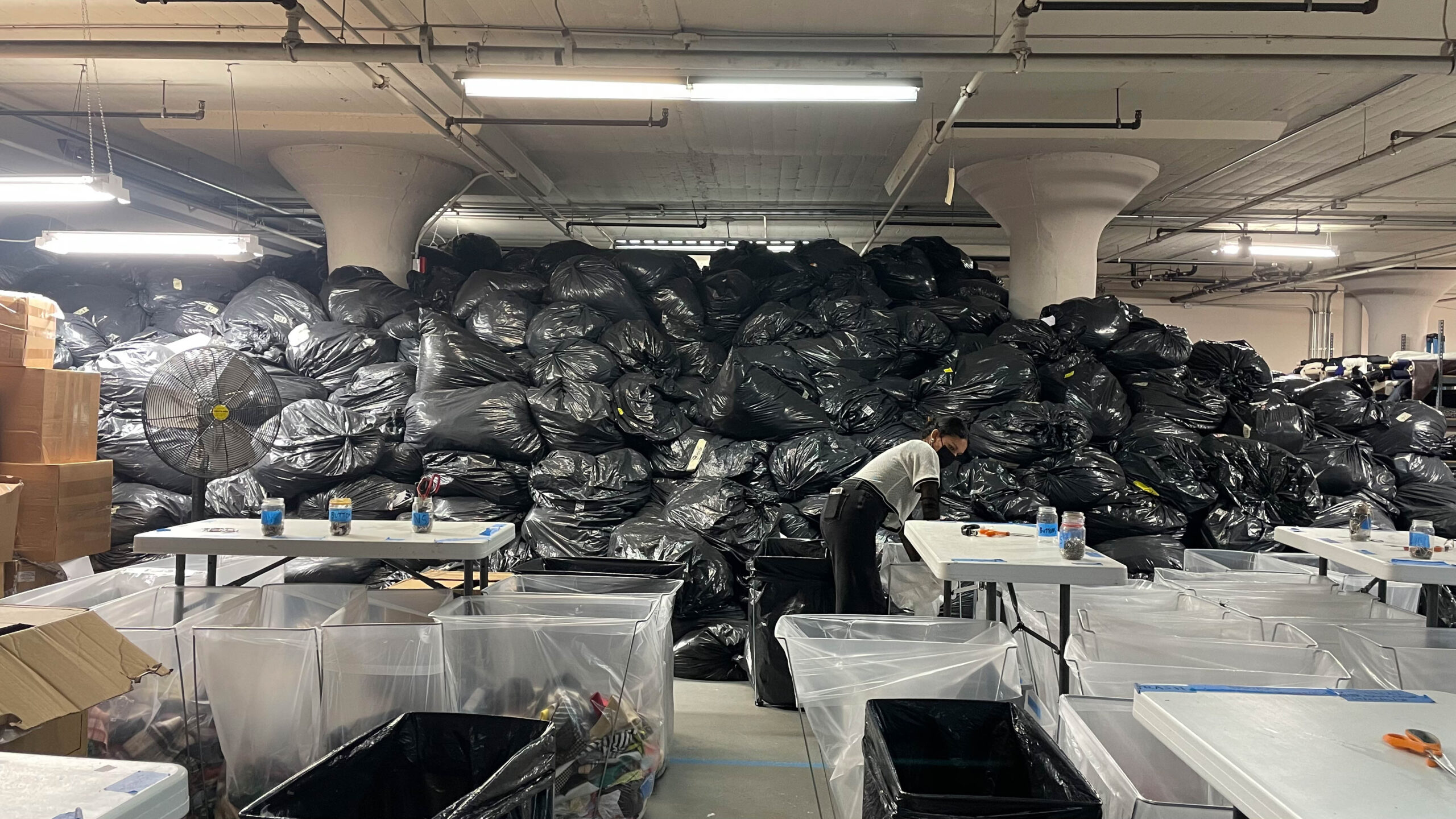
Piles of unused clothing and fabric scraps are sorted at FABSCRAP for recycle or reuse distribution.
Fast fashion results in mass-producing clothing that is lower quality in order to meet the ongoing current stylistic trends per year. Unfortunately, many fast fashion brands use synthetic materials that cannot be recycled, such as spandex, lycra, and elastane. Fast fashion has exacerbated the over-consumption in commercial textile waste and superfluous clothing found in landfills.
In the United States, the Department of Environmental Conservation (DEC) reported that 15% of our used clothing gets recycled; the remaining 85% of unused fabrics are either incinerated or tossed into landfill.
“Our priority is the waste stream. That is based on the fact that this is what we do [at DSNY],” said Westervelt. “We bring goods to the landfill…the less of that you can do, the better.”The Department of Sanitation’s (DSNY) DonateNYC and ReFashionNYC have contributed to the city’s role in reducing textile waste from landfills and emphasizing sustainable fashion.
Textile waste, or clothing waste, can be analyzed through the lens of transportation, total water and transportation use, toxins and dyes in clothing, and consumerism. With sustainable fashion, we can see how the products are made or sourced to best reduce overconsumption.
DSNY’s annual report provides data analysis with a proprietary reuse compact calculator. Similar to the Environmental Protection Agency’s WARM model, the calculator analyzes the greenhouse gasses saved by reuse activity and the environmental impact.
“Understanding the consumers’ and residents’ consumption habits are one part of the solution. Government intervention policies and programs are another part of the solution,” said Westervelt.
Immediately preceding New York Fashion Week—a world renowned event that presents designers and exclusive fashion material— DSNY and the Sanitation Foundation introduced ReFashion Week in 2019.
This event challenges buyers, designers, and spectators to look at the effect of textile waste.
With sustainable fashion, an individual can either recycle or reuse/upcycle excess organic fabrics. Recycling is the process of material that is shredded and repurposed—such as insulation for building or carpet padding.
Reusing or upcycling involves any artist or maker to take an organic or synthetic fabric. Used fabrics can create an entirely new piece or add onto an existing piece.
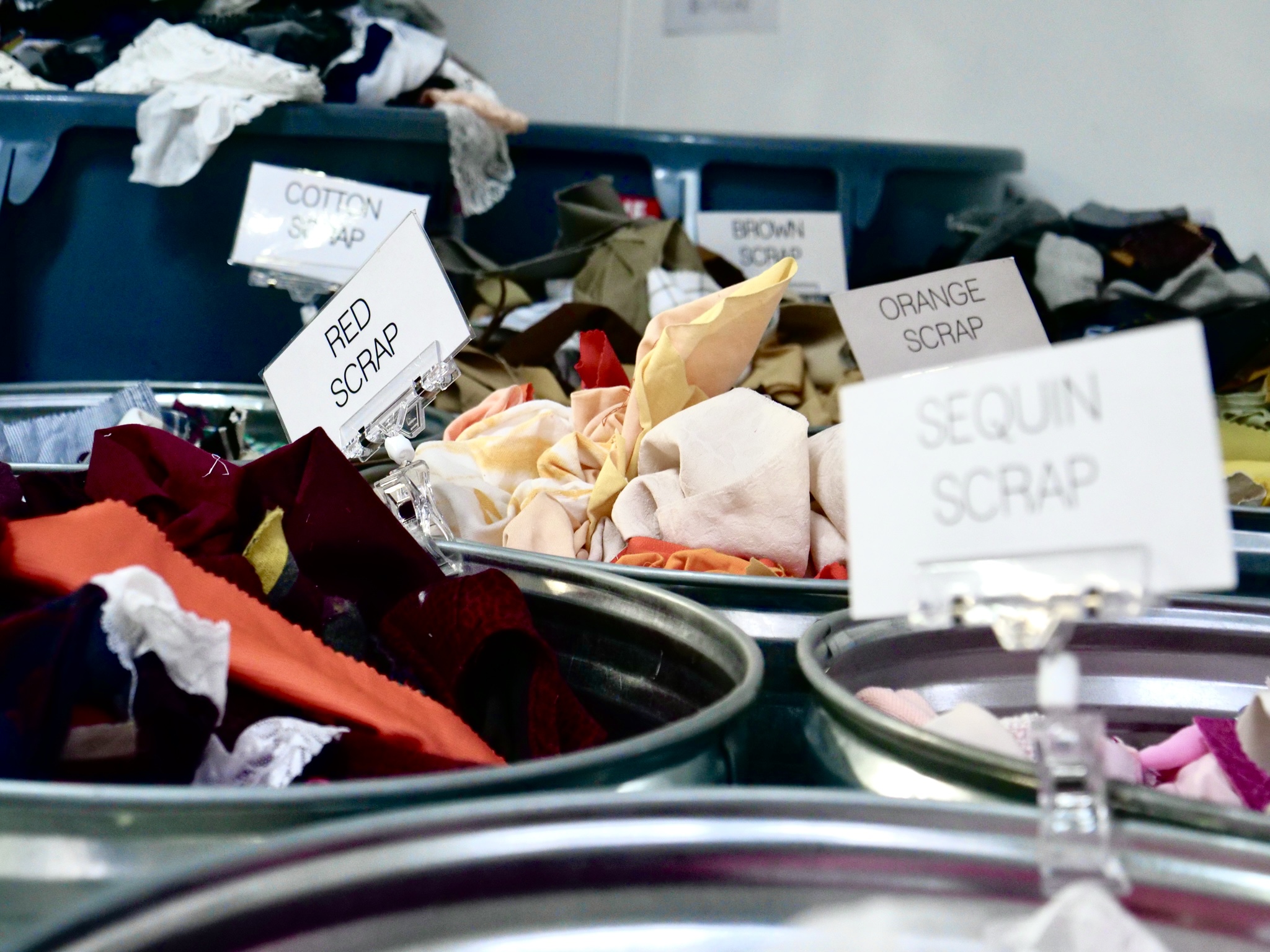
Fabrics are sorted by its color and material type.
Shawnte Brown, founder of Old Threads New Trends (OTNT), entered the sustainable fashion world after being inspired by second-hand clothing and thrifting. Brown defines herself and all artisans of sustainable fashion as makers when creating each piece with their bare hands.
Featured in ReFashion Week 2021, Brown emphasizes how long a product will last based on a few makers who carefully craft each piece as opposed to a larger supply chain that contributes to lesser quality.
“There’s just a better quality assurance of the garment as opposed to being mass produced in a factory somewhere where there are lifetime limits,” said Brown. “There isn’t a rush to have a bunch of different styles.”
Overproduction and overconsumption has resulted in the excess materials in landfills, thrift stores and consignment shops.
“People are constantly donating things and throwing things out,” said Brown. “We have to figure out a way to slow production.”
Brown emphasizes the need for business models to take the lead in sustainable fashion in order to reduce their pre-commercial textile waste in landfills.
“Companies have to respond by building sustainability into their business practices. That’s the only way we’re going to get through this,” said Brown. “As it stands now, I don’t think we will be able to be sustainable in the current framework we have.”
While some people may think of recycled clothing as old or used, sustainable fashion makers find a way to maximize unused fabric that can still be trendy or timeless.
“My motto is that I want people to look good, feel good and do good to themselves, to their environment and to others,” said Rakel Tanibajeva, co-founder and director of Lots of Berries.
Tanibajeva’s passion in fashion stems from her interest in sustainable alternatives and unique opportunity as a sustainability ambassador with New York Fashion Week. After participating in a positive environment in a niche of limitless creativity, Tanibajeva launched Lots of Berries.
Lots of Berries does haute couture— or high fashion clothing, that illustrates upcycled pieces alone. Tanibajeva pieces are all repurposed using existing fabrics or bases that are donated from thrift stores or other manufacturers.
“It is so understandably realistic to think about how environmentalism and sustainability can be incorporated into all aspects of life,” said Tanibajeva. “It truly is a part of everything in the way that we live.”
With upcycling, any maker or stylist can transform waste material or unwanted fabrics into something new. While this is one way to keep clothing as far away from the landfills as possible, DSNY states that any business is required by law to recycle or repurpose any fabrics or scraps if textiles make up more than 10% of its own waste.
“The legislation is there, but it’s an example that there are no teeth,” said Jo Corvus, Community Coordinator of FABSCRAP. “It’s like a law without the engineering behind it to support it.”
Founded in 2016, FABSCRAP is a nonprofit organization that seeks to fill the niche of servicing pre-consumer textile waste in New York City. Organization founders saw many designers wanting to recycle their scraps.
“On a community level, people think of sustainable fashion strictly as, ‘where am I buying my clothes? First or second-hand?’ It’s very consumer-based.” said Corvus.
Fabrics are sorted in bins based on its color and material type. FABSCRAP measures all unwanted and unused material from partnerships in the fashion, entertainment and interior design industries. According to their Annual Report 2020, FABSCRAP has diverted a total of 655,710 pounds of fabric from landfill since 2016.
In 2020 alone, FABSCRAP reported that 176,879 pounds of material was collected with 39% being reused, 51% recycled, and 10% in landfill. With 1,290 tons of CO2 saved, this is equivalent to 19,352 trees planted.
With the use of re-purposing organic fibers such as cotton, wool, hemp or linen, excess fabrics can be sold to makers such as Tanibajeva or Brown. The process maximizes the reduction in clothing waste.
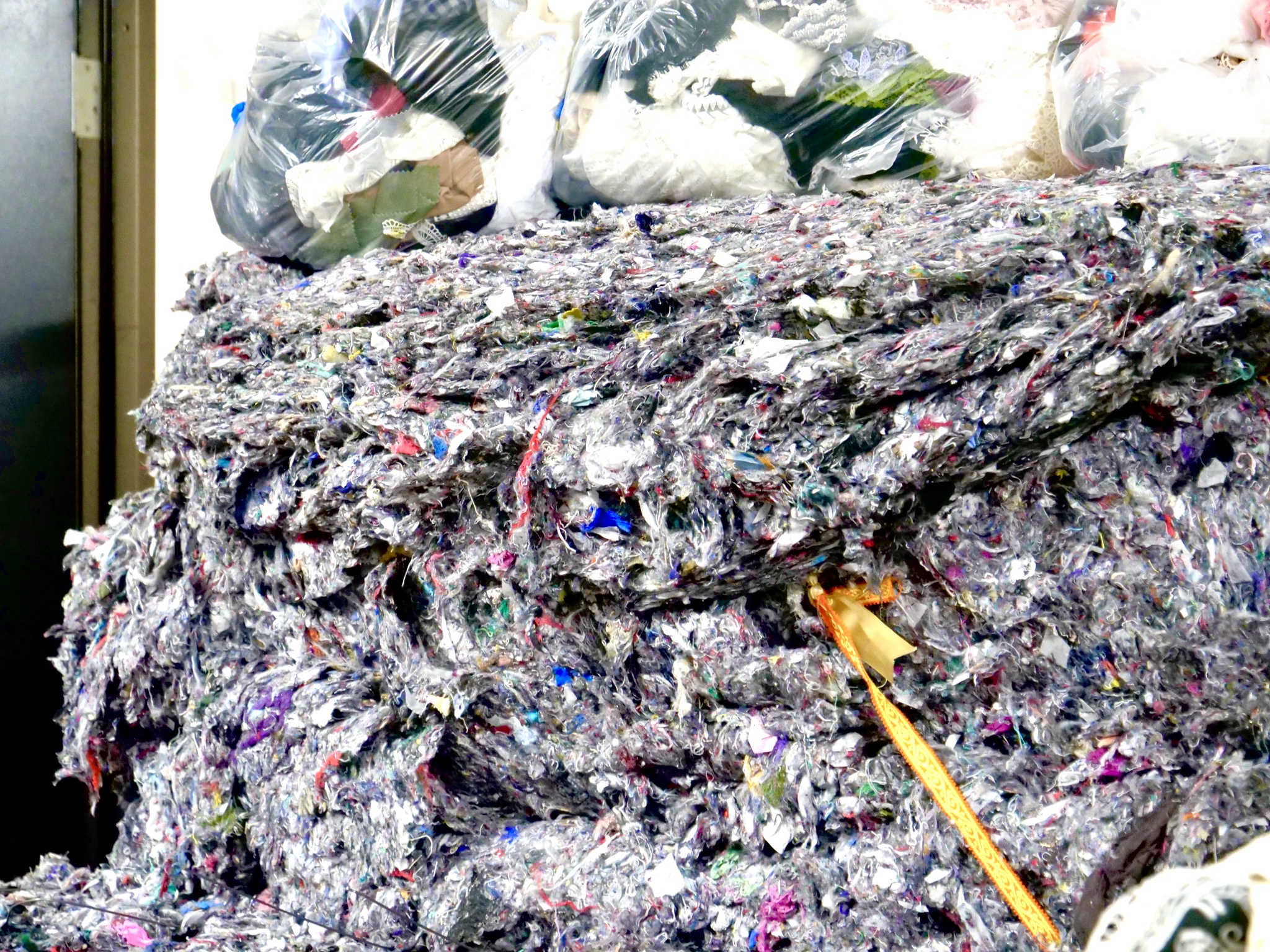
Excess fabric material and scraps can be recycled when it is shredded, also known as shoddy.
FABSCRAP offers recycling when shredding any fabrics and small scraps that can later be used as padding, furniture lining, insulation, stuffing, and moving blankets. Unfortunately, synthetic fibers will go to landfill if it is not reused by any makers.
“There are so many synthetic fibers and they can’t just go away… we’re all still figuring out the right way to use the resource at this point,” said Corvus.
According to the United Nations, sustainable fashion can lower greenhouse gas emissions. Consumer awareness and industry accountability toward the fashion industry can drastically reduce overconsumption and clothing waste.
For Brown, the narrative of where we consume and how we consume a product is a powerful tool to practice sustainable fashion. “Being a bit more mindful of when we buy and how we buy we will be a big part of that solution… there is no better way to state your case than with your money,” said Brown.
“When we think about sustainable fashion, it is so vast,” Brown said. “The different ways in which we can approach it is a beautiful thing for us to think about. It gives us opportunities.”
The Winding Journey of Brown Bins
What the Suspension and Return of Curbside Composting Looks Like
By Jiale Hu
A One-Man Trash Shuttle
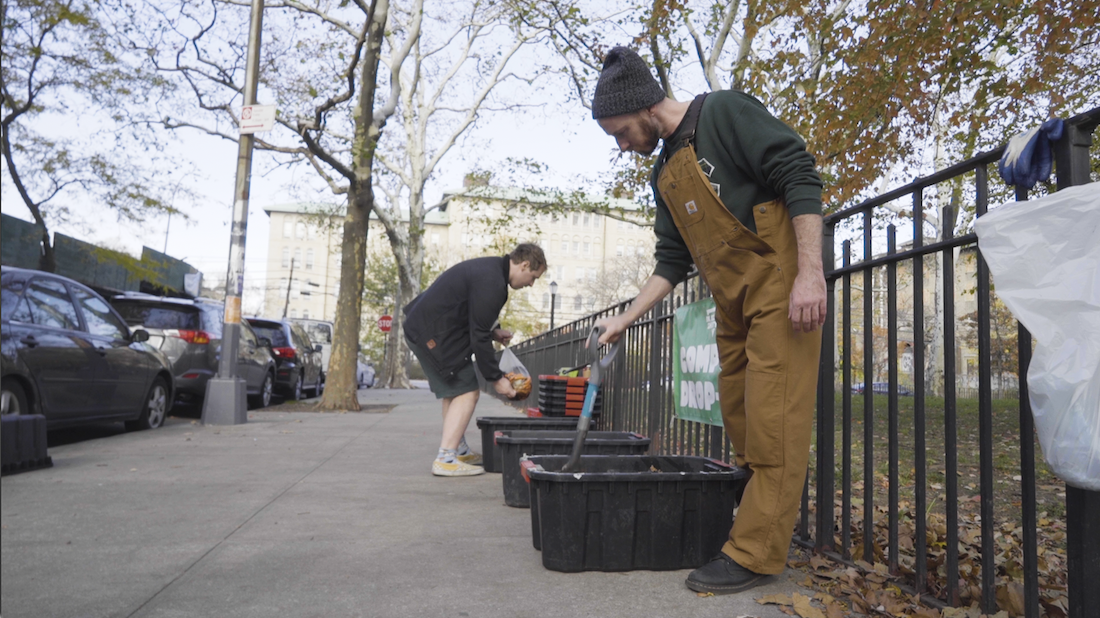
Clay Burch volunteering at Brooklyn Scraps Shuttle on November 21, 2021.
Clack, clack, clack.
Every Sunday outside of Cooper Park in East Williamsburg, there is a clattering sound. It’s always Clay Burch, shoveling frozen compost consisting of banana peels, coffee grains, and chopped vegetables.
The clacking sound is often interrupted by greetings from neighbors who come to drop off their food scraps. Occasionally, people ask if he’s here every weekend. Burch answers yes.
A freelance photographer in Brooklyn, Burch has volunteered to arrange a compost pick-up site called “Brooklyn Scrap Shuttle” almost every Sunday from 12-3 pm since May 2020 (the schedule changed to 12-2 pm since October 24, 2021). Burch’s consistent volunteering of his time, though beneficial to communal bonding in East Williamsburg, exists because of an unexpected event.
“I found out that they were no longer going to be picking up compost. And I was like… I can do it.” said Burch.
“They” refers to the New York City Department of Sanitation (DSNY). In April 2020, DSNY announced the suspension of Curbside Composting Program due to pandemic-induced budget cuts. The curbside collection of trash and recyclables were not affected.
A Citywide Truck Disappearance
Starting its pilot phrase in 2013, DSNY’s Curbside Composting program introduced brown bins for residents to discard their organic waste separately. By early 2020, the program expanded to 44 out of 59 community boards across all five boroughs.
Each building with less than 10 units automatically received the brown bin for weekly organic waste pick-ups.
That all changed when COVID-19 hit. The Department of Sanitation took a cut of $106 million, $24.5 million of which belonged to organics recycling. The priority shifted instead with $190 million in federal funding to DSNY for emergency food delivery.
“We are just…subject to the needs and pressing issues of the day,” said Hillary Bosch, the DSNY Brown Bin Community Outreach Coordinator.
Beginning in May 2020, trucks stopped coming for the brown bins.
Yet you still see them sitting on the New York City curbside. These brown bins look like grills displaced in winter or heaters in the summer—off-season tools that hold a vague promise of productivity in an indefinite future. They come in different sizes too. The bins with smaller sizes, almost half as tall as the blue and green bins next to them, look especially like decorations.
They were a part of the success story of how the Department of Sanitation moved towards Mayor Bill de Blasio’s goal of Zero Waste to landfills by 2030.
In the fiscal year of 2019, these brown bins diverted 154.7 tons of organic residential waste every day from landfills. This was a small step that decreased 0.7% of the daily organic residential waste. Given the same neighborhood coverage, DSNY Curbside Composting Program saw a significant increase of 12.6% tonnage collected from 2018 to 2019.
The defunding in 2020, unfortunately, paused the growth.
The annual reports for DSNY Curbside Collections show that citywide organic waste collection dropped from 154.7 tons to 6.6 tons per day from FY2019 to FY2021.
A 95% decrease of tonnage collected seems to have outdone the growth harvested over the past six years.
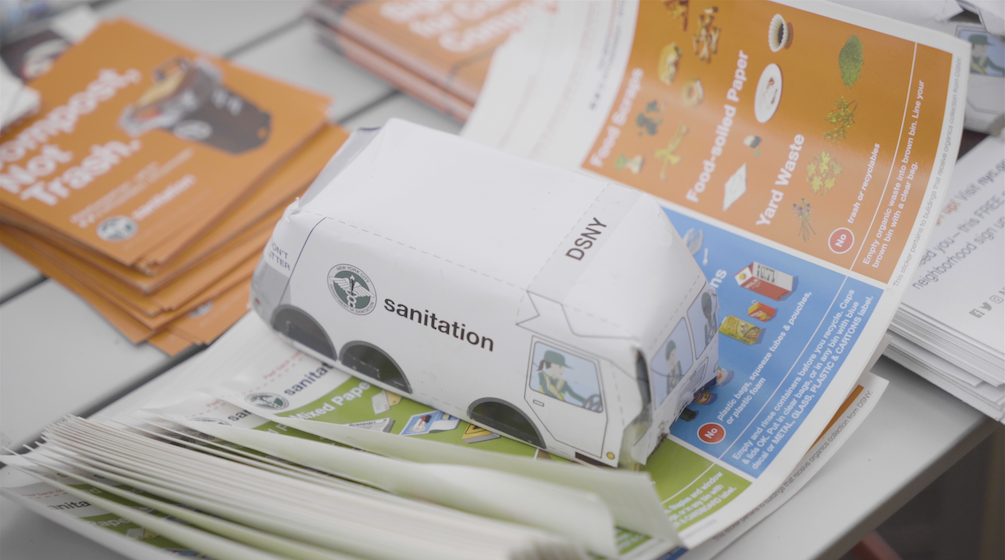
Layout of DSNY outreach materials
Why NYC Cares about Composting
In the Department of Sanitation’s latest Waste Characterization Study in 2017, organic waste consisted of 34% of the total residential waste of New York annually. Chances are, these organic waste such as fruit peels and dry leaves end up having the same destiny with regular trash. Together, they travel to remote landfills and get buried underground in Central New York, Pennsylvania, Virginia, and South Carolina.
For DSNY, landfills are costly trips. The annual cost of waste exports is $430 million in 2020, ranking as the fourth largest expenditure category, according to the New York City Council.
Moreover, landfill is the third biggest contributor to methane emission in the United States, amounting to 114.5 Million metric tons of CO2.
Separating the organic waste from the landfilled regular trash is ideal from an environmental and financial standpoint. Project Drawdown from Princeton University shows that the shift from landfilling to composting organic waste can reduce more than 50% of carbon dioxide-equivalent greenhouse gas emissions.
To Bin or Not to Bin: a Winding Journey
While the benefits of composting are straightforward, effective implementation takes a much more winding journey in the city.
In 1991, DSNY started with an “Intensive Zone Pilot” of 22,000 households in Brooklyn Community District 6, crossing Park Slope, Carroll Gardens and Gowanus. Two years later, the Department established a second intensive zone in a section of Starrett City in Brooklyn. In these zones, residents separated their own organic waste, and the Department of Sanitation sent them to the centralized facilities.
Similar to the Brown Bin program, these preceding intensive zone pilots are experiments of “centralized composting.”
The pilots were found to be inefficient in a 2011 program review. Amid challenges such as a high contamination rate, the cost of transporting the material was very high. Since each household had a small amount of organic waste, the high cost of developing new pick-up trucks could not be justified.
This gave birth to other “decentralized composting” experiments and outreach efforts.
In 1994, the longest running food scrap drop-off site launched at the Lower East Side ecology center. Four years later, the Backyard Compost Bin Pilot Program launched. In 2000, the first “Master Composter” course in the Bronx began to foster resident-run home and neighborhood composting sites instead of relying on municipal processing facilities. With these initiatives, DSNY assisted in fostering a composting culture among New Yorkers.
A harder look at centralized composting came in 2010, when the City Council passed Local Law 42 that requested an updated Assessment of Composting Opportunities for “composting a larger portion of the organics in NYC’s waste system.”
This was how the Brown Bin Curbside Composting Program came along in 2013.
An Absence Hard to Fill
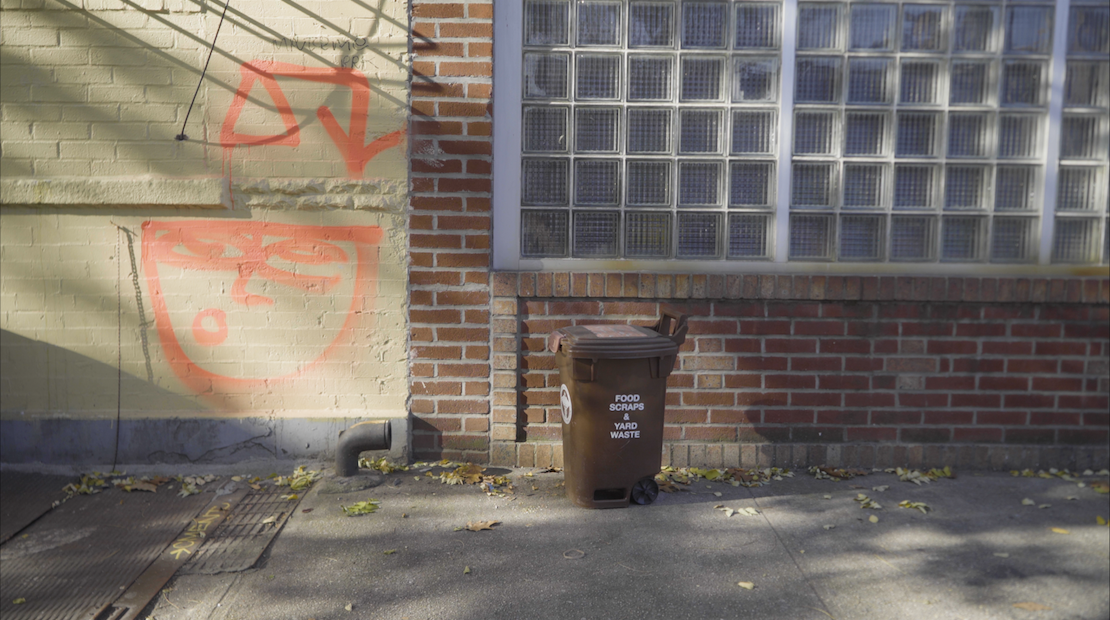
A brown bin left on the street in East Williamsburg in November 2021.
Carrying a DSNY brown bin on his skateboard, Hunter Stark approaches the drop-off site at Cooper Park. “It still does the job,” says Stark with a smile as he pours the food scraps into one of the collecting bins of Brooklyn Scraps Shuttle.
The annual difference of more than 54,000 tons of organic waste needed somewhere else to go.
DSNY suggested that regular trash was the option.
New Yorkers dedicated to composting tried to look for other alternatives. Similar to the 1990s when centralized composting program , decentralized composting such as local community drop-off sites have become even more significant in the city’s composting ecosystem.
The Green Markets hosted by Grow NYC had 76 pop-up sites available every week across the City by February 2020; however, this alternative stopped also during the citywide shutdown in March 2020.
It never returned to its full scale due to budget cuts.
“In April, we were told that we would simply have no funds for the fiscal year of 2020,” said Emily Bachman, the Assistant Director of Compost Program at Grow NYC.
Funded by the Sanitation Department, Grow NYC’s community compost drop-off services were on complete hold. Fortunately, the Save Our Compost coalition brought back less than 10% of the budget for composting programs in the City.
“That was totally just citizen advocacy,” said Bachman. “our portion of it was $500,000…about a quarter from the year before.”
Instead of 76, 16 compost drop-off sites by Green Markets were available for the entire year from September 2020 to September 2021.
Another alternative is community gardens that are independent of government funding. Often restricted to only members of the gardens, they also fail to meet a rising demand for composting.
“During the pandemic, we had many who wanted to drop their compost at our garden,” said Charlotte Bell at Red Shed Community Garden in East Williamsburg. “Really we can only handle what our members bring in.”
Other than compost drop-off sites offered by NGOs and community gardens, individual initiatives such as Brooklyn Scrap Shuttle might be the only option for some.
The Journey Continues
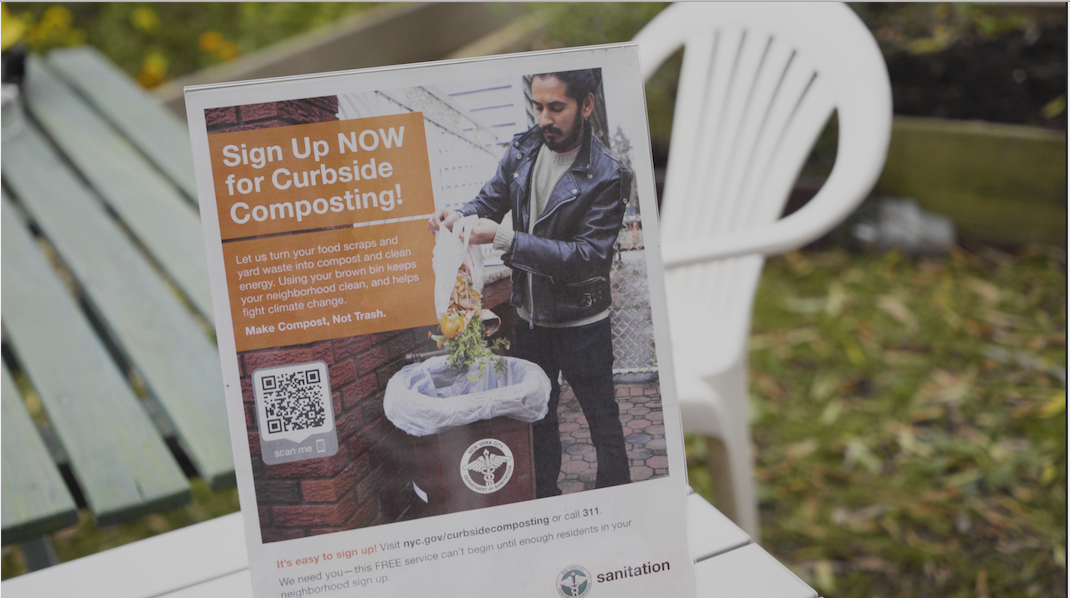
Sign-up poster displayed in Red Shed Community Garden on October 31, 2021.
“Have you heard about the return of Curbside Composting?” Clay Burch asked some neighbors who walked to dump the food waste. The answers varied.
“Yeah. I already signed up. Got an email that says on December 7.”
“Not yet… when will they come?”
“Did they push it from October to December?”
With a new fiscal year approaching, DSNY announced the return of brown bin pick-up services in April 2021. Seven out of 44 community boards that previously had brown bins now receive Curbside Composting again as of December 2021.
“With the limited budget, we are tasked to roll out at neighborhoods that would have the most interest, with the highest predictable tonnages,” said Bosch from DSNY.
To determine the interest level of community boards, New Yorkers need to sign up either on the DSNY website or through calling 311. The sign-up system assists the Department of Sanitation to conduct a monthly review of sign-ups, population density, household sizes, efficiency of route-planning and other factors.
Internally, this review helps the Curbside Composting team to coordinate new roll-out routes with other counterparts within DSNY. Externally, mapping sign-up interests also helps DSNY to request more funding to serve more neighborhoods.
At the current pace, such recovery struggles to meet a seemingly growing interest in composting.
A new convert to composting since 2020, Steve Lewis is a resident of East Williamsburg. He was trapped at home to cook more because of COVID-19. “I saw how much food waste I generated every day,” said Lewis, “and that turned on my switch.”
There is no comprehensive tracking of how many New Yorkers want to compost now versus before the pandemic. However, different compost collectors have witnessed an increase in active participation.
“Our sites have increased in participation anywhere between 50% and 300%,” said Bachman from Grow NYC. This exponential growth may also result from fewer composting sites.
Clack, clack, clack.
By Cooper Park, Burch is still chopping the frozen composts. Now that the brown bin service returns to East Williamsburg, he has not decided when to end Brooklyn Scraps Shuttle.
“It depends on how many people will keep bringing their food scraps to me,” said Burch. “At least do it through December… then I will reassess from there.”
Green Roofs
Looking Up for a Solution
By Clara Charrin
All around New York City, gray prevails. Pavements, roads, sidewalks, parking lots—the impermeable surfaces that cover the city are endless. As green is slowly taking over the dense urban landscape, the untapped resource that is the sea of tar and asphalt resting above our heads awaits utilization.
Far from being a simple aesthetic addition to our cities’ landscape, adding greenery up in the sky has become a major driver in the fight to make our urban spaces more sustainable in the face of climate change.
“Green roofs are such a unique and vital technology for establishing sustainability practices,” said Annie Novak, the co-founder and farmer at Eagle Street Rooftop Farm, a green roof in Greenpoint, Brooklyn.
Green roof infrastructures have been around for hundreds of years rising out of mythology as old as the Hanging Gardens of Babylon. But it wasn’t until 50 years ago, starting in Germany, that the green roof as a climate resilient technology started being developed.
Composed from top to bottom of plants, growing medium, a water retention layer, a root barrier coat and a waterproofing basis, this five-layer technology acts like a giant sponge that can soak up water, therefore decreasing the amount of rainwater that reaches the street level and reducing the risk of flooding. Additionally, through evapotranspiration—the evaporation from soil combined with vapor loss from plants—green roofs can lower the temperature of the air, mitigating the urban heat island effect.
The technology reached the United States a couple of decades ago, and though it was adopted slowly at first, it is now gaining momentum as American cities are trying to adapt to the increasing threats coming from extreme weather conditions. Cities like Chicago, Portland, and Denver are leading the way and implementing significant initiatives.
But New York is lagging behind.
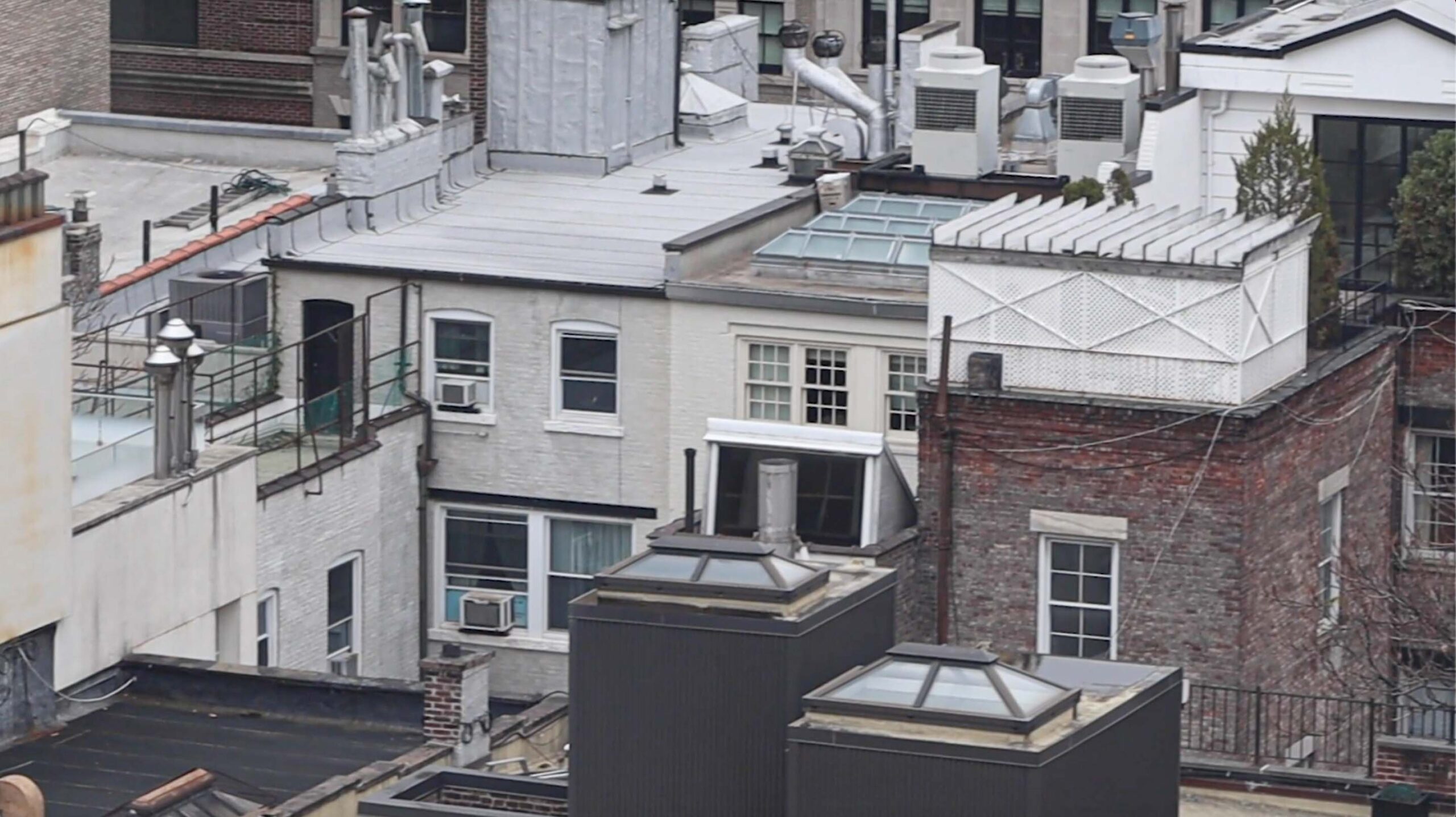
Rooftops on the Upper East Side.
In 2016, the first extensive and comprehensive report regrouping data to map out where green roofs were installed in the city was released by the Nature Conservancy. The map was created by putting together publicly available data and remote sensing technologies. It revealed that only 736 out of the 1 million buildings that cover New York had a green roof, representing only 0.1% of all one billion square feet of roofscape.
“The politics and size of New York do kind of make it unique. The megacity is different than Denver or Portland. We are making progress,” said Dustin Partridge, the Senior Ecologist & Green Infrastructure Lead at NYC Audubon.
Since this data was last released, the city has made a greater push to make the roofs greener.
In April 2019, the New York City Council passed the Climate Mobilization Act, with the aim to decrease the city’s carbon emissions by 80% by 2050. The sweeping legislative package was one of the most ambitious building emission set of laws enacted in any large city in the world. Specifically, Local Law 92 and 94 require all new construction to include a green roof, solar, or a combination of both. As such, New York became the biggest city in the United States to require new buildings to include green roofs.
Since the two laws were put in place, there has been no clear indication of how many green roofs have sprouted around the city. As the city released new data for 2020, Mike Treglia, the lead scientist at the Nature Conservancy, is currently working on updating the map. “Everyone is sitting on the edge. We are still in the early stages, but we are definitely seeing more green roofs,” he said.
“The results of this will be really interesting to see how many green roofs were installed between 2016 and 2020 […]. Staten Island as of 2016 only had two green roofs and they were both very small. But I know of at least six new projects that have gone on out there since that,” said Partridge.
Some doubt that the mandate will be enough to create the green roofs needed for New York City.
“Climate change is smacking us right in our face. New York does have this big green law that they passed, but what is happening?” asked Barbara Leatherwood, in charge of communication for Broadway Stages, a studio company whose sustainability efforts led to the creation of three of New York’s iconic green roofs.
The major obstacles to establishing more green roofs are the up-front costs and the lack of understanding of what the financial benefits for the building will be, which the mandate fails to address. Ranging from $15 to $35 per square foot, the installation of a green roof represents a cost that is two to three times higher than the cost of a standard asphalt roof.
Alan Burchell, the principal of Urban Strong, a for-profit company that installs green roofs in New York City, wants to convince people green roofs are a good economic bet. “If in order to defeat climate change we’re relying on people’s charitable nature, we’re screwed. You have to hit them where it counts, you have to prove that battling climate change, ridiculously enough, is going to have an economic return on investment for that individual person,” he said.
The multi-layer technology behind green roofs can drastically reduce the cost of energy by cooling the building during the summer and warming it during the winter. Additionally, the waterproof membrane extends the lifespan of the roof.
Regardless of these benefits, many building owners and developers still see the installation of green roofs as being too expensive. And as such, many have found ways to circumvent the mandate thanks to the many exemptions included in it.
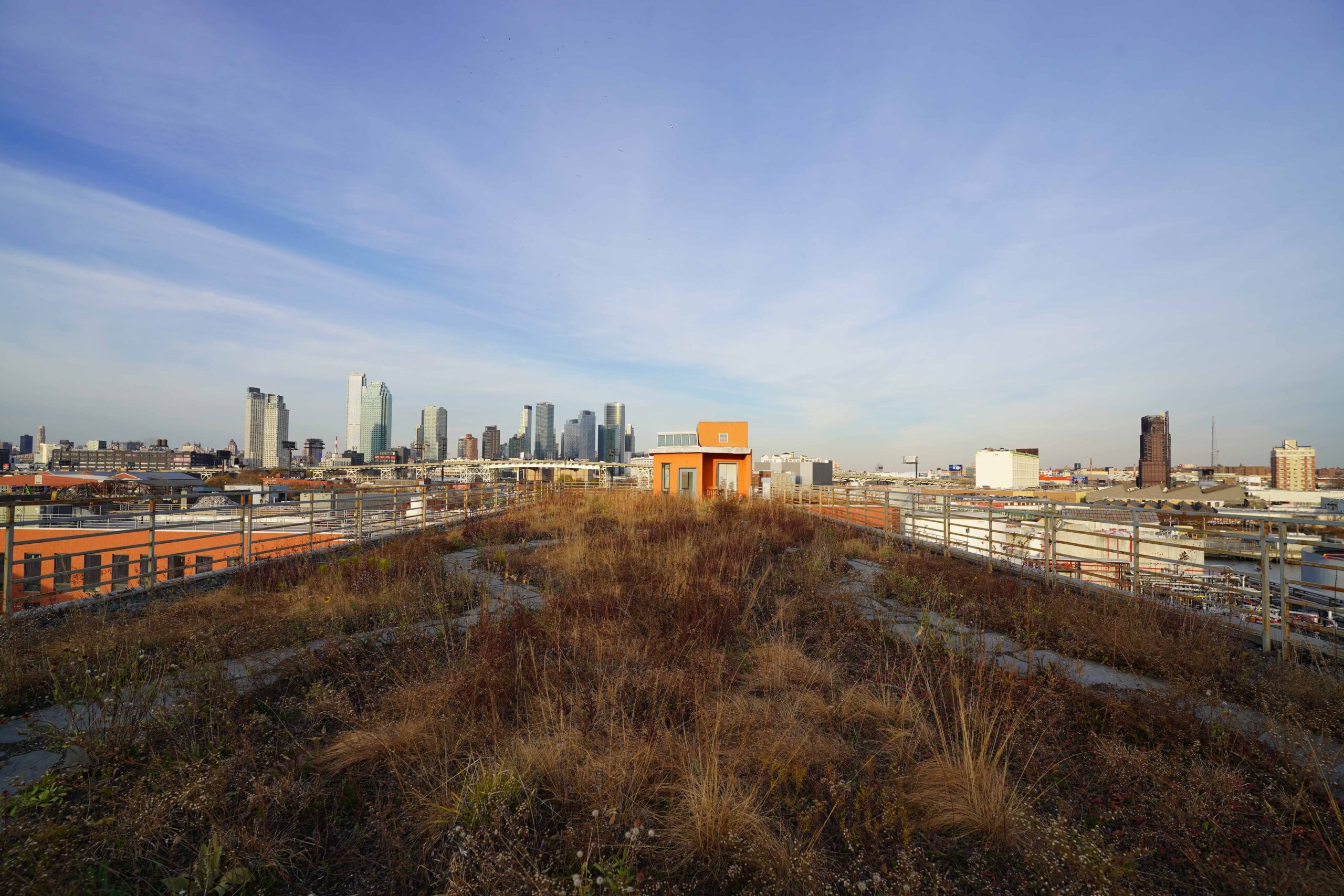
Kingsland Wildflowers – A green roof managed by the Newtown Creek Alliance, sitting atop Broadway Stages’ film studio in Greenpoint, Williamsburg.
Burchell compares green roofs to a “Swiss Army knife” of benefits and tools. These roofs can act as “our therapist, our air conditioner, our air purifier, our farmer, our firefighting Department, our insulators, and so on. No one technology does all of that.”
On top of mitigating the urban heat island effect and managing stormwater, various reports have proven there are many other benefits that can be reaped by the city—the installation of green roofs in a neighborhood can reduce crime rates, reduce the stress hormones of people who can see or access them, and promote biodiversity.
“The cost of that public benefit shouldn’t come from the people that are paying to install the Green Roof, at least not entirely because there is financial benefit to the city of New York,” said Partridge.
Compared to mandates like Local Law 92 and 94 that require individuals to comply with regulations in the face of the threat of fines, incentive programs such as tax abatements can help offset the initial cost of setting up a green roof.
In 2007, the New York City Council created the Green Roof Tax Abatement Program to provide individuals with a reduction of taxes payable to the city—$15 per square feet in priority districts and $5.23 per square foot in others.
Such funds have the potential to entice building owners to build green roofs but for the first nine years after its implementation, the program created only seven green roofs. For Shino Tanikawa, the Executive Director at NYC Soil & Water Conservation District, “the amount is too low, the bureaucracy is on arrest and there is no outreach to private property owners.”
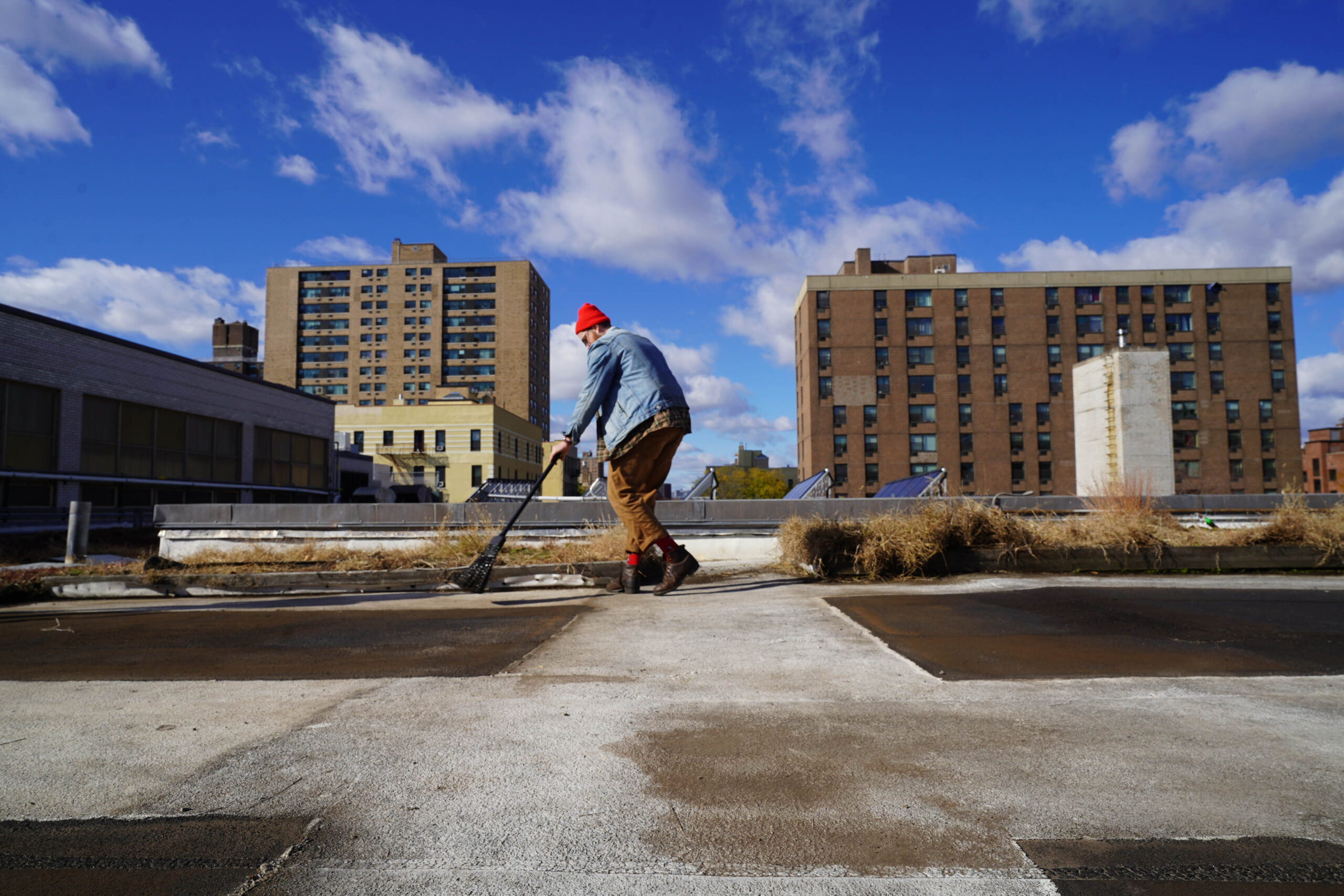
Volunteer working on the maintenance of the Saint Mary’s Recreation Center Green Roof
Different organizations have taken it upon themselves to create programs with complementary goals to raise awareness of these incentives and foster the deployment of green roofs.
“The challenge is to advance the advocacy for green roofs. We need more information and that requires prioritizing green research,” says Timon McPhearson, the director of the Urban Systems Lab.
In 2017, the Green Roof Research Association was created to organize all those working in the field.
“We honestly didn’t know who was doing research, who was working on green roofs in New york. It was maybe like 20 or so researchers and we realized that we weren’t even really speaking the same language,” said Partridge.
Since then, the group has worked on carrying out extensive research to dismantle the misconceptions about the technology, shed light on the available resources and incentives, and help bring green roofs into the mainstream.
Thanks to the combined efforts of policy makers, scientists, researchers and educators, the public perception and the interest in green roofs are growing.
“If the human species gets wiped out from climate change, it’s not going to be one thing that kills us. It’s going to be like death by a thousand paper cuts.” Burchell said.“And similarly, there’s no one silver bullet that helps heal death by a thousand paper cuts. It’s going to be a thousand little small Band-Aids that all together are going to stop the bleeding.”